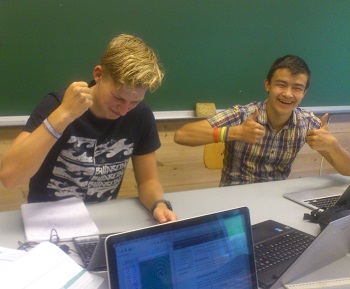Problem Based Learning (PBL)
This set of activities are designed for enthusiastic second year students with a good background knowledge of physics who have followed the 1st year activities and have a good working knowledge of Geogebra, Algodoo, Excel, Audacity, Capstone and LoggerPro plus associated hardware. it will be taken for granted that they also understand the principles of Mechanics, thermal physics and waves.
If the assignment turns out to be too difficult it is always possible to revert to the activities for a more structured approach or indeed to use the guided inquiry activity as reference material.
The PBL assignments will often contain far too much material to be completed in the normal class time but working as a team, students could complete everything.
This is an ongoing project, I will endeavour to keep ahead of my own class. I'm also not entirely sure how this will work but if it turns out not to be fun I'll scrap the idea.
Some of the exercises are a bit cryptic, this is part of the plan. the idea is that students will become good at solving problems and one of the most important stages in problem solving is understanding the problem. I will be preparing extensive support for teachers to help teachers understand what I am getting at. Please leave comments if you need clarification.
Doppler effect (PBL)
I've never played angry birds but know it's something to do with throwing birds, I guess that's what makes them angry. We are not going to throw the birds but we'll release them one at a time from a moving...
Single slit diffraction (PBL)
Take about 2 meters of plastic hose pipe and stretch it straight.You can build this in Algodoo by putting motors between lots of sticks, see if you can build one like mine.
Resolution (PBL)
The Rayleigh criterion enables us to calculate if two point objects will be resolved when the light from them passes through the aperture of an optical instrument.
Two slit interference (PBL)
PASCO make a set of slits with different width and spacing.On this disk are two inclined slits (variable double slit).Build a simple model in Geogebra to show how the fringe pattern is formed as a result...
Two slit interference (PBL)
PASCO make a set of slits with different width and spacing.On this disk are two inclined slits (variable double slit).Build a simple model in Geogebra to show how the fringe pattern is formed as a result...
Multiple slits (PBL)
Shine laser light through the 3 parallel slits on the PASCO multiple slit set and observe the subsidiary maxima formed between the main interference fringes.Try modelling 4 and 5 slits
Thin film interference (PBL)
Camera lenses often have an antireflective coating. This thin film of transparent material reflects part of the light at the first surface and part at the second. The two reflected waves interfere destructively...
Polarisation (PBL)
The analogy of waves in a string passing through a slit is often used to introduce the concept of polarisation. Design an experiment to test if you can actually polarise a wave in a string and if the...
Gravitational potential (PBL)
A 1kg ball is at the bottom of the 10m deep, round hole shown in the image.The ball is pushed out of the hole at constant speed by exerting a force in the horizontal direction.Lines of equipotential are...
Orbits (PBL)
(1) All planets move about the Sun in elliptical orbits, having the Sun as one of the foci.(2) A radius vector joining any planet to the Sun sweeps out equal areas in equal lengths of time.
Electric fields (PBL)
You can't see an electric field but you can visualise it by drawing lines of equipotential and field lines. Take a piece of conductivity paper and draw a point in a circle with the silver pen. Connect...
Alternating current (PBL)
If you pass an DC source of PD, V was connected to a resistor, R the power dissipated would be V2/R, but if an AC supply of peak voltage, V was connected to the same resistor the power dissipated would...
Electromagnetic induction (PBL)
A motor is a coil that rotates in a magnetic field, so is a generator. In this investigation you will use a small electric motor to generate electricity. Take a look at the motor mounted on the table.

